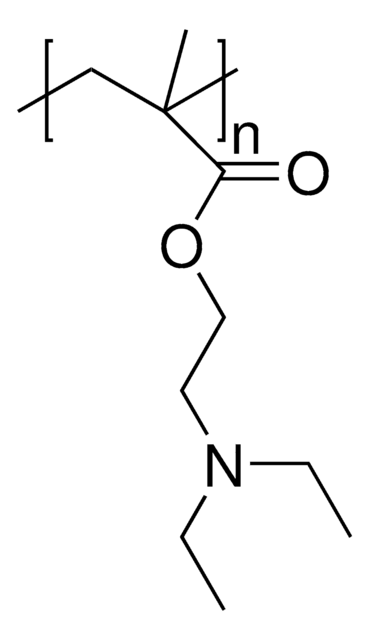928925
Poly(ethylene glycol)-block-poly(2-(Dimethylamino)ethyl methacrylate)
quaternized, PEG average Mn 5,000, quaternized PDMAEMA Mn 18,000
Synonym(s):
PEG-PQDMAEMA, Quaternized PEG-PDMAEMA
Sign Into View Organizational & Contract Pricing
All Photos(1)
About This Item
Linear Formula:
CH3(C2H4O)nC6H7O2N(C9H18O2NCl)mC7H5S2
UNSPSC Code:
51171641
NACRES:
NA.25
Recommended Products
General description
Poly(ethylene glycol)-block-Poly(2-(Dimethylamino)ethyl methacrylate) quaternized (PEG-b-PQDMAEMA) is a biocompatible block polyelectrolyte composed of a neutral PEG block and a cationic quaternized Poly(2-(Dimethylamino)ethyl methacrylate) (PDMAEMA) block. The PQDMAEMA carries quaternary ammonium salt moieties along the polymer chain.
Application
- Antimicrobial applications
- Non-viral gene delivery
PEG-b-PQDMAEMA is a versatile polymer with applications in antimicrobial applications and gene delivery. Due to its high efficacy in antimicrobial systems, it is an ideal candidate for the fabrication of long-lasting, contact-active bactericidal materials. PQDMAEMA is also a promising material for non-viral gene delivery. PEGylation of PQDMAEMA reduces cytotoxicity and increases gene delivery efficiency.
Storage Class
11 - Combustible Solids
wgk_germany
WGK 3
Certificates of Analysis (COA)
Search for Certificates of Analysis (COA) by entering the products Lot/Batch Number. Lot and Batch Numbers can be found on a product’s label following the words ‘Lot’ or ‘Batch’.
Already Own This Product?
Find documentation for the products that you have recently purchased in the Document Library.
Quaternized poly(2-(dimethylamino)ethyl methacrylate)-grafted agarose copolymers for multipurpose antibacterial applications
Xu LQ, et al.
Royal Society of Chemistry Advances, 5, 61742-61742 (2015)
Film Properties and Antimicrobial Efficacy of Quaternized PDMAEMA Brushes: Short vs Long Alkyl Chain Length
Koufakis E, et al.
Langmuir, 36, 3482-3482 (2020)
PDMAEMA based gene delivery materials
Agarwal S, et al
Materials Today, 15, 388-388 (2012)
Our team of scientists has experience in all areas of research including Life Science, Material Science, Chemical Synthesis, Chromatography, Analytical and many others.
Contact Technical Service






![Poly[(2-ethyldimethylammonioethyl methacrylate ethyl sulfate)-co-(1-vinylpyrrolidone)] average Mw <1,000,000 by GPC, 20 wt. % in H2O](/deepweb/assets/sigmaaldrich/product/structures/334/533/03fcaede-76a6-4b5a-a992-9565ea1ace4a/640/03fcaede-76a6-4b5a-a992-9565ea1ace4a.png)

